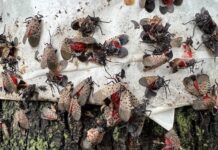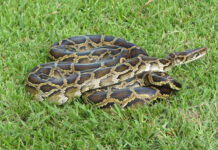
One of the methods to help control the spotted lanternfly (SLF) invasion is having unintended negative consequences. According to officials fromNJ-based The Raptor Trust, glue traps being attached to tree trunks have been injuring and killing birds, according to an article posted in NJ.com. As of early August, The Raptor Trust had responded to 61 cases involving birds that were caught in glue traps — including 53 in June and July alone. Of these 61, 15 recovered and were released, 23 remained under care with injuries, and the rest died.
“Once they’re in that trap, they’re struggling to get free,” Christopher Soucy, executive director of the non-profit Raptor Trust, told NJ.com. He noted that the birds suffer from “feather damage and abrasions, skin damage, as well as trauma and stress and shock.”
“While the SLF is of great concern in our area, the unintended consequences of this method of remediation far outweigh its effectiveness, and in some cases the by-catch victims are they very things that might prey upon the lanternflies in the first place,” the bird rehabilitation group posted on its Facebook page.

As a result, The Raptor Trust doesn’t recommend the use of glue traps. To protect birds and other wildlife, those using sticky bands should tack nylon window screening loosely around the band (seen at left) to prevent other creatures from getting stuck. Penn State Extension has a short video that shows how to properly use sticky bands.
But there is a better alternative, say experts: a circle trap. “This new style trap is made of plastic-coated insect screening and does not use any sticky material at all. It is basically a tunnel that SLFs walk into. When they move upward in the trap, they end up in a dead-end collection container where they die.” Turf found this circle trap on Amazon for $46.97, or this one at Great Lakes IPM for $26.97, (though we’ve never personally used these brands). Alternately, instructions for making your own from Penn State Extension can be found here.

Landscapers who want to obtain traps for clients may want to look into funding or reimbursement options. This past Spring, the City of Harrisburg, PA, offered circle traps to its residents free of charge. The N.J. Department of Agriculture also recently announced that reimbursement funding (as much as $15,000) is available for all New Jersey counties for costs they accrue for chemical treatment activities associated with SLF control. Information about the grant can be found here.
Meanwhile, SLF is spreading its range. Cliff Sadof, an entomology professor at Purdue University and a contributor to Turf’s just published August issue, reported that SLF was found in late July in Huntington, IN after a resident reported “mutant ladybugs” feeding on trees of heaven on their property to a “Huntington Neighbors Helping Neighbors” facebook page. According to Sadof, finding SLF this far north of 2021’s find along the Ohio River in Vevay, IN makes it possible for SLF to be anywhere in Indiana. Anyone who spots signs of the spotted lanternfly should contact the Indiana Division of Entomology and Plant Pathology (DEPP) by calling 866-NO EXOTIC (866-663-9684) or send an email (with a photo of the insect if possible) to DEPP@dnr.IN.gov.
Is SLF a problem in your area? Here’s an idea: host an SLF circle trap building workshop. You’ll benefit the community and get new customer leads!
For more on SLF circle traps, chemical controls, and more, see Handling Spotted Lanternfly On Client Properties.











![[VIDEO] Dickies®: Discover Workwear That’s Anything But Uniform](https://turfmagazine.com/wp-content/uploads/2023/06/1647663814-4b1a2a7742790a9b1e97a3b963477850192e1d6a9dfba9b07214a77bae25d6e3-d-218x150.jpg)





























![[VIDEO] Dickies®: Discover Workwear That’s Anything But Uniform](https://turfmagazine.com/wp-content/uploads/2023/06/1647663814-4b1a2a7742790a9b1e97a3b963477850192e1d6a9dfba9b07214a77bae25d6e3-d-324x160.jpg)